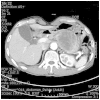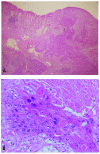Primary squamous cell carcinoma of the stomach: A case report
- PMID: 25289093
- PMCID: PMC4186502
- DOI: 10.3892/ol.2014.2492
Primary squamous cell carcinoma of the stomach: A case report
Abstract
Pure squamous cell carcinoma (SCC) of the stomach is rare and resembles SCC arising elsewhere in the body. The pathogenesis of SCC remains unclear and controversial. At present, <100 cases of primary SCC of the stomach have been reported. The current study presents a case of SCC of the stomach in a 61-year-old male. Total gastrectomy was performed and a 7.0×6.7×4.5-cm tumor with a superiorly located ulcer was identified in the cardia. Upon histological examination, a moderately-differentiated SCC was observed. Tumor cells extended to the serosa, and the perigastric regional lymph node was also involved. No evidence of human papillomavirus (HPV) or Epstein-Barr virus (EBV) infection was identified using a DNA microarray and in situ hybridization, respectively. A post-operative computed tomography scan four months after the gastrectomy revealed tumor recurrence and dissemination of the tumor to the jejunum and pancreas. The patient succumbed to the disease six months later despite the administration of low-dose adjuvant 5-fluorouracil/cisplatin chemotherapy.
Keywords: squamous cell carcinoma; stomach.
Figures




References
-
- Straus R, Henschel S, Fortman DJ. Primary adenosquamous carcinoma of the stomach. A case report and review. Cancer. 1969;24:985–995. - PubMed
-
- Parks RE. Squamous neoplasms of the stomach. Am J Roentgenol Radium Ther Nucl Med. 1967;101:447–449. - PubMed
-
- Schwab G, Wetscher G, Dietze O, Schmid K, Pointner R. Primary squamous cell carcinoma of the stomach in a seventeen-year-old boy. Surg Today. 1992;22:561–564. - PubMed
-
- Marubashi S, Yano H, Monden T, et al. Primary squamous cell carcinoma of the stomach. Gastric Cancer. 1999;2:136–141. - PubMed
-
- Tokuhara K, Nakano T, Inoue K, Nakane Y, Kwon AH. Primary squamous cell carcinoma in the gastric remnant. Surg Today. 2012;42:666–669. - PubMed
LinkOut - more resources
Full Text Sources
Other Literature Sources
Research Materials
